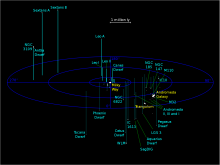Listen to today's episode of StarDate on the web the same day it airs in high-quality streaming audio without any extra ads or announcements. Choose a $8 one-month pass, or listen every day for a year for just $30.
You are here
A Dull Neighborhood
Our galactic neighborhood is a long way from the bright lights of downtown. But the boring location is also a lot safer. We don’t have to worry about exploding stars, neutron stars, black holes, and some of the other threats that fill the Milky Way Galaxy.
The heart of the Milky Way is jam-packed. Stars are separated from each other by light-months or even days. Powerful magnetic fields loop through star clusters and clouds of gas and dust, causing some to collapse and others to stay spread out. And in the past, the galactic center has produced millions of powerful stellar explosions. Today, the massive corpses of those stars orbit the supermassive black hole at the galaxy’s hub.
That’s probably not a great environment for giving birth to planets. And it’s an even worse environment for nurturing life. That doesn’t mean life can’t exist there — only that it seems unlikely.
Our solar system is about 27,000 light-years from that chaos — half way from the center to the edge of the galaxy’s disk.
Stars out here are widely spread. So are the nurseries that give birth to stars. Because of that, we’re hundreds of light-years from any stars that are likely to explode. And there are no known neutron stars or black holes within thousands of light-years.
So our skies are a lot darker than those of many other regions in the Milky Way. But we face fewer dangers from the neighbors — making our part of the galaxy much more comfortable for life.
Script by Damond Benningfield






